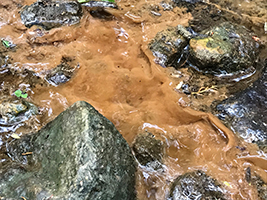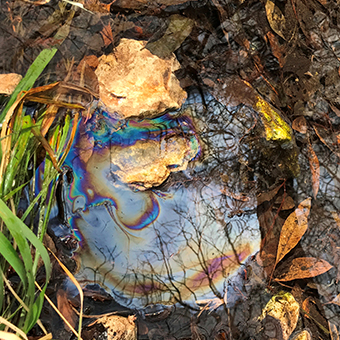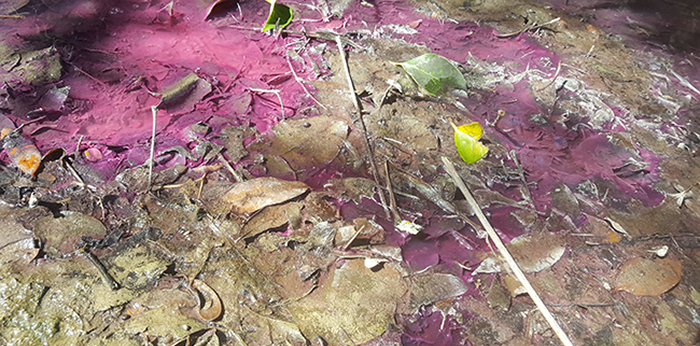Austin’s creeks used to run clear in the wilderness, but now they run through the built environment of the city. They pick up pollution from all of us. The concrete and rooftops of the city cause their flow to vary wildly, swinging from dry to overflowing during heavy storms.
The Colorado River, too, has changed. Dams have been built to create reservoirs, our beloved Highland Lakes. These lakes have multiple purposes, including drinking water supply, recreation, energy generation, and flood control.
Monitoring
We monitor the water quality in our lakes and creeks in order to understand how the urban environment affects our water bodies and to develop effective policies to protect them. Our main goal is to improve the overall health of our watersheds and the benefits they provide to our community..
- Find water quality information for our creeks and lakes on our interactive map.
- Visit the State of Our Environment Report for the most recent monitoring results.
- Creeks: Monitoring
-
We have several monitoring projects that are designed to answer specific water quality questions. We also routinely monitor several creeks quarterly each year for:
- Dissolved oxygen, pH, temperature, and conductivity
- E. coli concentrations as a surrogate for pathogens
- Turbidity and total suspended solids for sediment load
- Nutrients (nitrogen and phosphorus), and
- Annual surveys for aquatic life integrity (the diversity and complexity of aquatic invertebrates and algae)
The data is collected in the Environmental Integrity Index, which has more than 30 years of data. It provides a rigorous and quality-assured dataset and gives us a firm basis for establishing regulations and planning projects to help maintain or improve the integrity of our aquatic resources.
- Lakes: Monitoring
-
We monitor and assess Lake Austin, Lady Bird Lake, and Lake Walter E. Long. We sample and rate the following aspects of the lakes:
- Characteristics of the water (temperature, clarity, nutrients, bacteria, etc.)
- Sediment chemistry
- Algae
- Aquatic insects
- Habitat of the shoreline and areas near the shore.
We then assign each lake an annual score, which can range from very bad through excellent. All three lakes tend to score as “fair” in the middle of the range. Annual data is captured in the Austin Lakes Index. This system was developed in 2010 and allows us to monitor trends over time.
- Monitoring Data Collected
-
E. coli
We expect E. coli bacteria to be present in creeks and lakes at low levels from wildlife. High levels can indicate contamination from sewage, pets, livestock or humans. When levels of E. coli are abnormally high, we gather additional data to help identify the potential source of the problem.
Nutrients
High levels of nutrients can come from fertilizers and wastewater contamination and can cause water quality problems including algae blooms and fish kills.
Aquatic Life
A healthy ecosystem has a good balance among its bugs of plant eaters, predators, and those that eat decomposing organic matter. The presence of sensitive species that are intolerant to pollution also indicates good water quality.
Diatoms and Algae
Diatoms are a microscopic type of algae. We collect them in our creeks by scraping the surface of rocks in the stream with a metal brush. Diversity in these samples can indicate water quality. Our scientists count and identify 500 diatoms in each sample to get a good representation of the community. In our lakes, we take water samples to check the diversity of a variety of types of algae.
Physical Conditions
These help determine how much water is flowing at the time, how stable the banks are, and the quality of the habitat.
Sediments
Annual sediment samples are sent to a lab to analyze for metals, industrial chemicals such as PAHs and PCBs, pesticides and hydrocarbons.
Special Concerns
Our monitoring activities help keep us informed about the health of our lakes and creeks. There are also some specific topics that may affect our experience outdoors.
- Mosquitoes
-
The word “mosquito” is Spanish for little fly. At best, they seem to be a quick snack for dragonflies and at worst, they are a vector for disease. They have changed the course of human history and remain an important part of the ecosystem.
Austin’s creeks are not mosquito habitat
Mosquitoes spend their larval stages in water and emerge as adults. But only 0.0019% of the insects we collect from creeks are mosquitoes. That’s because Austin-area mosquitoes have evolved to avoid laying their eggs in streams and ponds. These waterways are full of their predators. Mosquito larvae are delicious food for a lot of fish, frogs and predatory aquatic insects like dragonflies, damselflies and beetles.
Container-breeding mosquitoes
In our area, most mosquitoes are part of a group referred to as “container breeding mosquitoes.” These species select small, temporary, stagnant habitats as their egg-laying sites. Their natural habitats are places like cavities in trees, pools of rainwater on top of bedrock and small puddles left from receding floodwaters. Residential areas expand their options immensely. Here are some likely habitats around your home:
- Clogged gutters
- French drains
- Pet dishes
- Bird baths
- Buckets
- Potted plants
- Old tires
- Tarps
Most often the sources of nuisance mosquitoes are found within a few feet of the home.
Control Mosquitoes
Conduct a careful inspection of areas around the home and reduce or eliminate containers of standing water. Bird baths and pet dishes are okay, as long as the water is not allowed to stand for more than four days. When treatment is absolutely necessary, fungal and/or bacterial treatments are better than broad spectrum pesticides. They are better suited to targeting mosquitoes and other flies without affecting other beneficial organisms. These types of treatment are most effective when they are used in proper places like gutters, rain barrels, yard drains, air conditioner condensate collectors, etc.
- Trash
-
We can all agree that trash in our creeks and lakes is gross. Cleanup is difficult and expensive for taxpayers, and it can ruin our beautiful natural recreational areas.
Our lake crews remove debris from Lady Bird Lake between Tom Miller and Longhorn Dams and maintain its 14 miles of shoreline. Each year, between our lake crew and volunteers, we pull approximately 11 tons of trash from Lady Bird Lake. An additional 4,500 tons are removed annually from Austin streets.
Some of these discarded items are dropped directly into the river, but most trash washes in during rainstorms. The trash enters the creek through storm drains from streets, parking lots, sidewalks, and parks.
Trash Study
In response to public concern, we conducted a field survey in 2022 to better understand the sources and distribution of trash in and near Austin’s waterways. We also conducted a benchmarking study of strategies to address it.
What did we learn?
- Single-use plastics were the most common items observed.
- Trash tends to accumulate in specific locations. 76% of all the trash was observed in only 10% of the study area. Knowing the locations where trash concentrates may improve the efficiency of future cleanup efforts.
- The locations where trash accumulates are based on the characteristics of the creek rather than nearby human activity.
- The sources of trash in our waterways is complex and is a result of the entire community. There is no one source primarily to blame.
- Only 21 scooters were discovered in creeks for an average of 1 scooter every 5 miles. This is despite the thousands in use around town. Austin now has a process to quickly get scooters out of creeks. If you see a scooter in a waterway, please contact Austin 3-1-1 or use the Austin 3-1-1 mobile app to report the location and brand so we can have them removed immediately.
What are strategies to help?
There are three approaches. The most effective solution is reducing the amount of trash in the first place. There is much that we can do as a community to make that happen. We also can intercept the trash and prevent it from reaching the creeks. Lastly, we can remove it once it’s already in the creek. The most expensive of these solutions is removal. See the Research and Publications section to read through the studies.
What Can You Do?
- Don’t litter!
- Volunteer for a cleanup or to mark storm drains.
- Educate other adults with Trash Travels Video or Trash Travels Posters (Waller Creek poster - Shoal Creek poster).
- Educate youth with Litter Be Gone Patch Pals Activity Kit.
- Unusual Colors
-
Austinites sometimes reach out about unusual colors seen in our creeks. Some of these vibrant colors are natural. Others are a concern. Here’s a quick guide to help identify some of the possible natural sources:
Orange Slime
A bright orange slime is often seen where groundwater seeps out of the ground. The slime is called “ferrihydrite.” It is basically like rust that is made by bacteria. It looks gross, but is natural and harmless. The orange slime is the byproduct a complex chemical relationship between two different sets of bacteria, one underground, the other at the surface.

Oily-Rainbow
A film of harmless bacteria called Leptothrix discophora can form a rainbow sheen on the water. When the sun shines on these bacteria, it makes shiny rainbow colors. These bacteria are helpful, processing iron and manganese in the water. Sometimes you can see their rainbow sheen where groundwater comes to the surface. Sometimes you’ll see it when air bubbles surround leaves under the water. However, a rainbow sheen can also indicate motor oil, which is a problem.

Purple Powdery Fluff
A bacterial group known as “purple sulfur bacteria” may cause a purple coloration in stagnant, well-lit, waters may be. These bacteria are good because they take hydrogen sulfide, which is stinky and toxic, and turn it into harmless sulfur. The conditions must be just right though!

All of these bacteria thrive under very special conditions and depend on other bacteria for their survival. We usually associate life with oxygen, but these bacterial communities depend on a source of water that is devoid of oxygen.
Creekside areas are complex, fascinating and wonderful places full of surprises and interesting biological and chemical phenomenon.
Check out our Water Quality Color Guide to learn more about what’s in our water!
- Zebra Mussels
-
Highly destructive zebra mussels have invaded many popular Central Texas waters, including Austin-area lakes. People can easily spread this invasive species from one body of water to another without knowing it. Young zebra mussels are invisible to the naked eye, and millions of them can live undetected on wet items for days and form new colonies when introduced into another body of water.
Clean, drain, and dry your boat!
This is true not only for motor boats, but even for canoes, kayaks, paddle boards, jet skis, fishing gear, bait buckets, swim suits, wet suits, and water shoes.
Every time you leave a water body, your boat must be:
- Cleaned off, with water at least 140 degrees Fahrenheit.
- Drained thoroughly from the motor, bilge, live wells, and bait buckets.
- Dried. It is recommended that boats and trailers be dried an entire week before entering another body of water.
It is a Class C misdemeanor to possess or transport zebra mussels, as well as other invasive aquatic species in Texas. Please visit texasinvasives.org/zebramussels/ for more information on the proper cleaning and draining of boats.
What’s the problem with Zebra Mussels?
- They can significantly alter water quality, which affects other aquatic life, including fish.
- They can encrust boat hulls, docks, and bulkheads.
- They can clog motors, intake pipes used for personal irrigation, and damage navigation buoys.
- They can also cause serious maintenance issues for water and energy providers by clogging intake structures. One study estimated the cost to the energy industry at $3.1 billion between 1993 and 1999.
Spotlight on Boggy Creek
A large granite sculpture by local artist Philippe Klinefelter captures incredible elements of Boggy Creek's history. The 5-foot tall, 24,000-pound artwork includes a carving of the creek winding through East Austin and highlights the area's ancient underwater volcanos, fossils (including mastodon bones), and Native American trail more than 10,000 years old. The sculpture is located on the Govalle Elementary School campus and is accessible to the public whenever school is not in session.
Report Water Pollution
Research and Publications
- Trash in Creeks: A field survey of trash intensity and source types in Austin, Texas, 2022
- Trash in Creeks: Benchmarking Solution Space and Resources, 2022
- Creating a multi-metric index for describing the environmental integrity of Austin area lakes, 2011
For more articles, visit our publications database.

